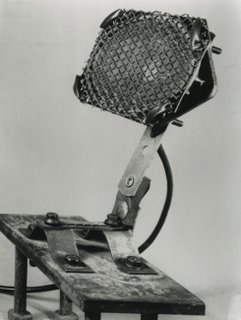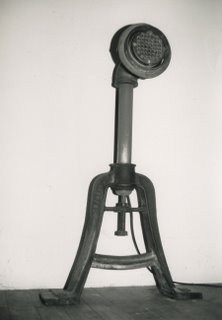Chop Shop - Humming The Sweet Quiver
Chop Shop is an ongoing electronic performance art project founded by Scot Konzelmann. Scot has successfully mixed physical art with what I have come to call "Atmospheric Industrial Music," a type of formless low frequency sound bordering on White Noise yet hypnotic at the same time to the listener's ears. Fascinated by Scot's interesting work I contacted him to learn more about his unusual speaker constructions. Photography by R. Marsters and F.B.
----------
AC- What were some of the things that contributed to the starting of Chop Shop?
SK- Essentially, Chop Shop was started as a vehicle to purvey pure sound experiences, hammered into a distinct focus. Leading to this was the desire to, in effect, turn up the volume on the hum of the world, selectively crawling inside particular sounds. An introduction to RRRon Lessard led to my first cassette activity, "Primitive Power/Positive Force" in 1987.
AC- How did you get the name for this experiment, and what does the name represent or mean to you?
SK- Chop Shop is common slang- referring to clandestine garage operations that disguise or modify stolen vehicles. This seemed to me appropriate; taking something found and sometimes familiar... modification, heavy handed alteration... "new" form. Once my work with the speaker constructions began, the moniker took on further, more direct connotations.
AC- When you first began Chop Shop, was your original intent focused on speaker construction as performance art pieces, or were you more interested in musical construction?
SK- Well, the speaker constructions came later. Initially, Chop Shop was a tape project.
AC- Do you consider yourself to be a performance artist or a musician?
SK- Neither. "Sound Artist" is the term that I am usually saddled with, which seems a bit more applicable. As I see it, my activities relate more an attitude of "music of decay..." if music must be used as a description. I was once dubbed a "noise mechanic," which I like. Conveys the Frankenstein approach...
AC- Please tell us of your previous musical involvement prior to Chop Shop.
SK- Rather varied, suffice it to say that Chop Shop is where I have found my niche. While I will admit some formal training in "conventional" musics and recording techniques, I maintain, at a root, a strong reliance upon instinct.
AC- Your speaker constructions seem to be somewhat complex. How did you begin to build them, and did you have any electronics training which helped you to accomplish this?
SK- Actually, a simple response: to instill a more interesting listen, I addressed the loudspeaker... taking a source of playback information and altering both it's function, and appearance. Giving the sound a body, so to speak. The speaker constructions do apply an understanding of acoustical function, however, adherence to any correctness is, for the most part, cast aside. The origins of this work began with a beautiful iron plate from an old furnace, featuring an 8" circular indentation. The visual element was immediately solid; I drilled out and mounted a speaker to the plate and proceeded to pump frequencies through it, determining how it reacted. Electronics training? All I did was pick up a soldering iron.
AC- In a previous interview you made the statement, "Physical sounds through visible sources." Does this accurately describe your music?
SK- Absolutely, this remains a strong description.
AC- How would you describe your sound constructions if the above statement would not apply?
SK- An attempt to establish a more direct listening experience.
AC- When you perform live I assume you would only use your speakers to convey the sound.
SK- There is no live performance, in the conventional aspect. My work is presented primarily in installation format and recordings with supportive documentation. In a way, the speaker constructions were developed to become the "performers..." for I have little interest in manipulating tape recorders in front of an audience.

AC- How often do you record new sound constructions? What is involved in this process?
SK- Whenever my equipment, and I, are working in reasonable order. Involves formation of a distinct sound or combination of sounds, determining approach, and pushing it until it works, or the equipment is rendered inoperable.
AC- When you work to create new sound material, do you often build new speakers specifically for that sound material?
SK- Ideally, the speaker constructions are developed in a dialog with the sound materials, but things do not always mesh that neatly, or at the same time. Ultimately comes down to what works, what fits the purpose. While each speaker construction in singular, final form has a specific sound program, I will often run alternative programs to allow for more interactive play between constructions in an installation format. This leads to role assignments in titled installations; for example, in "Speed, Aggression, Violence and Desire" each speaker construction was given a program that embodied its capabilities... in keeping with its assigned part.
AC- There seems to be a two-fold creative process that must be difficult to work with at times. You construct sound, and you construct objects. Do you find yourself going back and forth from sound to objects frequently, or do you attempt to work on both aspects of Chop Shop simultaneously?
SK- It is a juggle. Again, ideally the work is pulled together simultaneously, but is done in stages...developing sound materials, assembling the speaker construction, a period of joining the two, recording and modifying the results.

AC- What are some of the new sound/speaker constructions you are working on at this time, and what do we have to look forward to from Chop Shop?
SK- Nothing definite. Always have piles of scrap on the workbench, projects in various stages. Since the RRR "Steel Plate" package took so long for me to get together, I am now focusing upon showing the constructions-while I consider what the next recorded release will be.
AC- I've read that you had some of your equipment stolen early on in Chop Shop's existence. Would you please tell us about the circumstances that surrounded this unfortunate experience and how you overcame it?
SK- The loss led to a definite change in approach, as financially I was unable to replace the items taken with ones of comparable quality. The result was to use whatever I could get my hands on, and push it into the ground... giving my recordings a particular edgy, precarious quality.
AC- When you are designing your speakers,do you alter the construction of the speaker mechanisms themselves to distort the sounds further, or do you simply concentrate your efforts on the outer construction?
SK- A bit of both, depends upon the application/desired result. While the speaker's "new" housing comprises a distinct quality of function, I may damage or manipulate the speaker unit itself. The sound material itself can be "tailored" for reproduction through each individual construction, using equalization to compensate or exaggerate the particular properties of each.
AC- Where do you find material to build your speakers with, and what types of material do you like to use for the building of new speaker housings?
SK- Scrapyards, abandoned mills, construction sites, roadside... I look for odd pieces with the potential to hold, or support a speaker in an interesting assemblage.
AC- You've mentioned speaker installations frequently. Could you elaborate to what an installation consists of, and how it is used?
SK- Installations featuring the speaker constructions vary, some incorporate use of several, say up to 6; or can consist of a single piece- depends upon the particulars of the situation. A recent show at Generator in NYC (somewhat dormant at the moment) Titled "Velocity and Vibration" featured 5 speaker constructions. One piece ran constantly at a low level while 4 others ran through a shifting "Program" each sound and speaker construction presenting itself individually, occassionally all stating a "common thread," then a breaking of order, interrupting, fighting- all in all a fifteen minute cycle, endlessly repeating in a medium sized room. The sonic content was all based upon sounds which to me typified movement, speed, and action- hence the title. Use? A direct experience for the adventurous listener...

AC- What have been some of your favorite speaker constructions?
SK- Personal favorite is also the first... Furnace Plate C1679. I have utilized this particular construction in many situations, and have blown the speaker several times; with each re-fitting the piece changes. Currently features a firm, two-way Bose System, that has held up under extreme duress...
AC- While you may be considering what the next release by Chop Shop might be, can you give us any hints as to what is on the drawing board?
SK- At present, I am placing myself on the workbench, trying to hammer out solutions to some nasty situations... aside from that, crawling around scrapyards, getting my hands good and dirty, fortifying my tape recorders for the duress of the next projects, and keeping my ears open.
----------
This interview originally appeared in Antocularis issue #2, January 1993.





0 Comments:
Post a Comment
<< Home